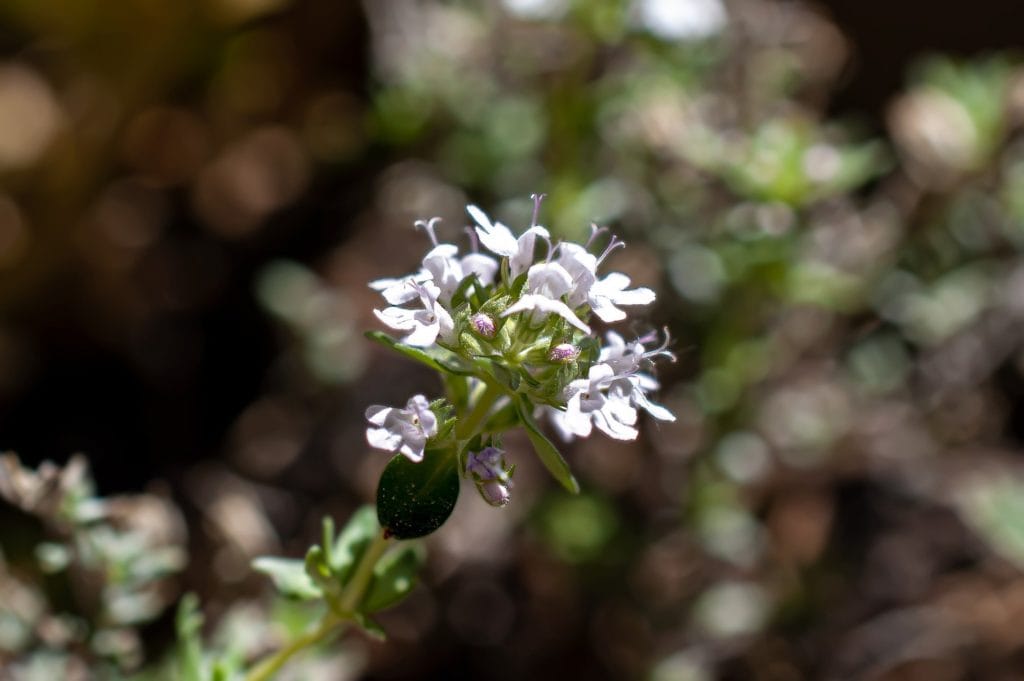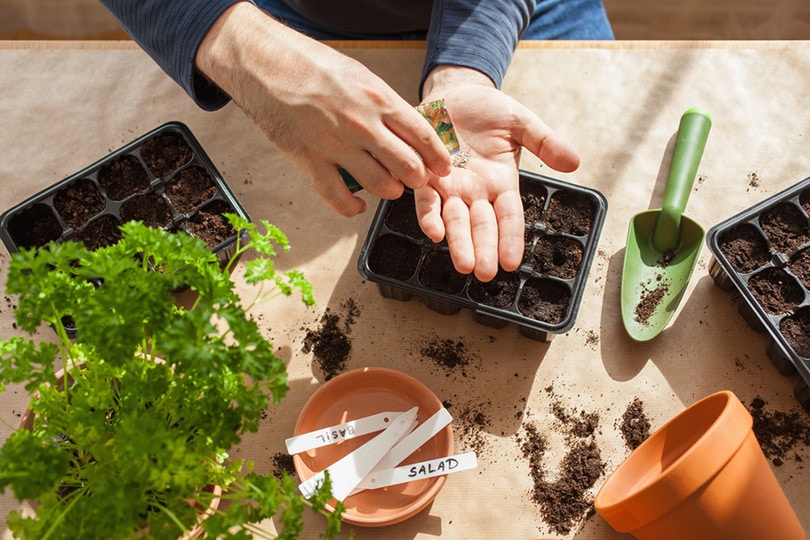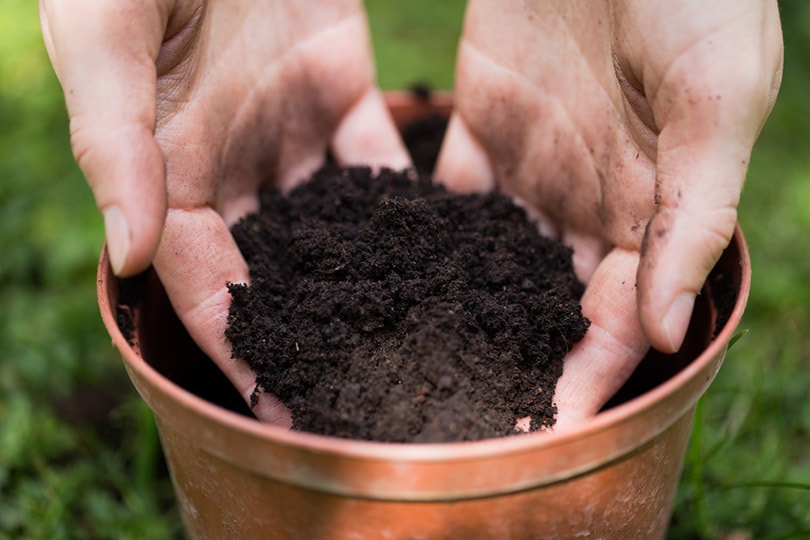How to Grow Thyme Indoors: Tips, Tricks & Step-by-Step Guide
-
Pete Ortiz
- Last updated:

If you’re the type of home cook who appreciates the value of fresh herbs, getting started on your indoor herb garden can be one of the best ways to give your dinnertime meals a boost. With its myriad health benefits and bright, versatile flavor, thyme is one of the most worthwhile starting points.
Thyme is an undemanding perennial, a hardy plant that home gardeners of all skill levels can grow with confidence. Make this delicious herb a feature of your household garden by following these simple tips and tricks to grow thyme indoors.
Where to Grow Thyme Indoors
Thyme enjoys sunny, dry conditions. Find a spot where it can receive 6–8 hours of direct sunlight, preferably a south or west-facing window. You can also use supplemental fluorescent lights if you cannot provide enough direct sun exposure. Grow your thyme plants indoors under artificial lights for 12–14 hours in place of natural sunlight.
Humidity and temperature are critical considerations as well. Thyme thrives in 60°F–80°F temperatures with little humidity. Areas prone to moisture, like kitchens and basements, aren’t the most suitable locations. You’ll also want to keep it clear of vents, furnaces, appliances, or anything that might affect the temperature.

Soil Requirements
Thyme needs dry, well-drained soil to keep moisture to a minimum. Too much water and root rot are the primary concerns in growing this otherwise low-maintenance herb. To create the best growing conditions, use potting soil with plenty of sand alongside peat moss and perlite.
Choosing a Container
Drainage in the container is as crucial as drainage in the soil to prevent thyme from sitting in water. Choose a pot with at least one large drainage hole in the bottom. An absorbent ceramic material, such as terracotta, will help dry the soil between waterings to maintain the roots.
Thyme does not need much soil space to grow. You can plant it in a pot as small as 4” wide, but make sure it is at least 6” deep. As the plant grows and spreads to its full size, you may need to upgrade the pot or consider planting it outside.

Watering Requirements
Thyme is a highly drought-tolerant plant, and it is best to err on the side of underwatering it to keep it healthy. Only water your thyme plant after the soil completely dries. Check the top 2–3 inches of soil, and if it’s dry, saturate the soil deeply.
Using Fertilizer
Thyme does not need rich soil to flourish, but that doesn’t mean a little fertilizer can’t go a long way. You can apply a diluted organic liquid fertilizer like fish emulsion at half strength early in the growing season. Use it every couple of weeks for the first few weeks of growth.
The Step-By-Step Guide on How to Grow Thyme Indoors
1. Sow Seeds in a Clay Pot
You can sow thyme seeds in a clay pot or a starter tray. After sprouting in the tray, you can move them to ceramic pots.
If you’re planting seeds in a pot, sow 3–4 seeds to improve the chances of getting a quality plant. Cover them lightly with soil and keep the soil moist while the seeds germinate. Place the container in a sunny spot with a temperature around 70°F.
Thyme takes a while to germinate. It usually takes 2 weeks for seedlings to sprout, but it could take up to 4 weeks in some cases. To help expedite the process, you can soak the seeds for a day before planting them.
After the seeds sprout, find the best one and get rid of the others. Thyme needs to grow by itself without competing for space in a pot.
2. Trim Flowers and Woody Stems
You may see flowering on your thyme plant, and while you’ll want to prune them, they aren’t a cause for concern. Unlike other herbs, it isn’t a sign of bolting and flavor loss when thyme flowers. Trim off any flowers and woody stems to keep the plant focused on developing healthy foliage.
Thyme flowers make an excellent garnish for meals and additions to salads and vegetable dishes. You can also use them in a healthy herbal tea.

3. Harvest the Leaves
Once the thyme plant is grown, you can start harvesting its foliage at any time. For the best flavor, cut stems off right before the flowers begin to open.
While you can trim off stems whenever you need them, it’s helpful to perform a substantial harvest 3–4 times each growing season. Harvesting helps inspire more abundant growth. Only take a third of the thyme plant at most during these harvests, as taking too much can hinder it.
4. Re-pot Every 2–3 Years
After a few years of growth, your thyme plant can become woody, signaling it’s time to separate the plant and re-pot it. You may also notice it becoming root bound, where the roots start trying to escape from the pot through the drainage hole. Remove the plant and pull it apart at the root, separating it into 3–4 plants. Pot these segments in individual containers.
You can transplant indoor thyme to an outdoor garden as well. Move the plant to a spot that sees full sun once the temperature stays consistently above 60°F. In the chilly months when temperatures dip below 60°F, it’s time to bring your thyme plants back inside.
Watch for Pests
By growing your thyme from seeds or propagating from your current plants, you can avoid bringing insects home from potted plants at the store. Still, thyme can fall victim to a few irritating pests, particularly mealybugs and whiteflies. Applying neem oil is a safe and effective way to combat both of these nuisances.
Final Thoughts
You’ll be so glad you decided to grow thyme indoors as soon as you start adding fresh leaves to flavor and garnish your dishes. With few maintenance demands, using homegrown thyme is one of the easiest ways to enhance your mealtime preparation. By following this straightforward guide to caring for your indoor thyme plants, you’ll have thriving plants to enjoy for years to come!
Featured Image Credit: Ole Schoener, Shutterstock
Contents



